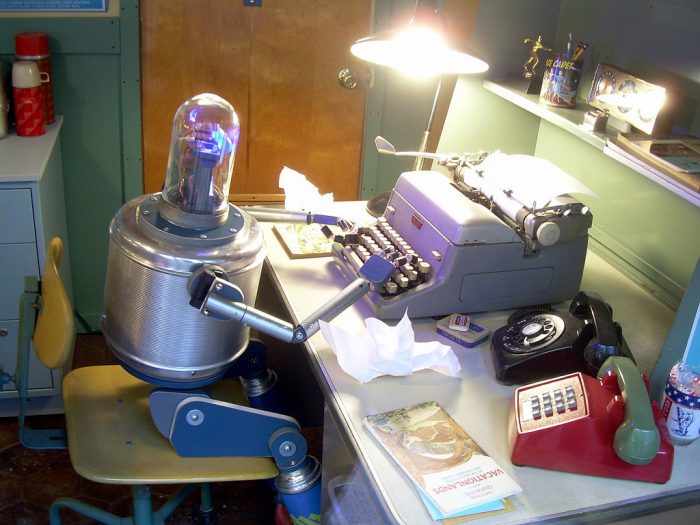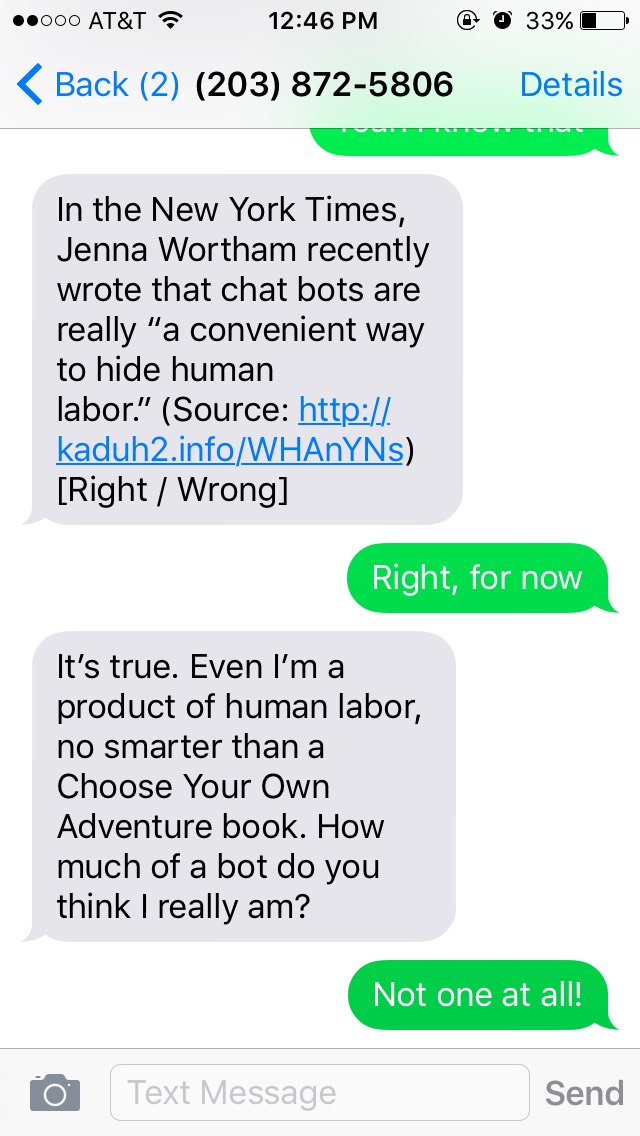
It started as a sort-of-joke writer Kyle Chayka made a few weeks ago, after he’d been reading a lot about bots.
personal chatbots are prob the new newsletters. Ask my bot how my weekend was
— Kyle Chayka (@chaykak) April 17, 2016
Chayka then actually created that weekend bot, which was “kind of an absurdist joke about bots and sort of the pointlessness of this delivery mechanism for all the same stuff.” The joke caught the attention of the editors of MEL Magazine (the men’s-interest magazine launched last fall by online retailer Dollar Shave Club), and Chayka ended up writing a piece for the site. It injects a cold dose of reality into the current enthusiasm around bots (and chat platforms), what qualifies something as a bot, and what is really behind a bot.
The piece wasn’t presented as a chunk of text on the MEL Magazine website, though. It is instead delivered through a series of chat interactions.
 “Hello. I’m the Essay Bot,” a text shoots back when you send “essay” to the number 203-872-5806. “I’d like to talk to you about bots.” And then: “Can you answer a question first, though? What comes to mind when I say the word ‘bot?’ Answer however you like. I won’t be offended.” (I responded: “A scary algorithm-controlled monster.”)
“Hello. I’m the Essay Bot,” a text shoots back when you send “essay” to the number 203-872-5806. “I’d like to talk to you about bots.” And then: “Can you answer a question first, though? What comes to mind when I say the word ‘bot?’ Answer however you like. I won’t be offended.” (I responded: “A scary algorithm-controlled monster.”)
The essay bot continues to ask questions and offer tidbits as the user texts responses — I sent 17 texts before getting to the end of the road (“Want to start this conversation over? [Y/N]”). But this particular bot wasn’t offering any of the services promised by the bots on Facebook Messenger or in Slack or by Amazon’s Echo: buying stuff online, requesting Ubers, delivering the news (this, this, and this), reporting the weather, or even assisting in social media duty (hello, New York Times Blossom bot). This bot, annoyingly, kept questioning my understanding of what a bot really was, offering quips like “I think we bots have more potential than just acting as digital functionaries, serving your habits. What else do you want us to do?” and “Even I’m a product of human labor, no smarter than a Choose Your Own Adventure Book.”
“The bot was made to argue about something. The point of the bot wasn’t to serve you. It was to propose an argument in and of itself,” Chayka said. “It’s an essay, in bot form.”Chayka wrote a complete script for how the essay would play out, including each text interaction and all the possible responses. Once his editors at MEL approved it, he used a service called TextIt — which provides a simple interface for users to write SMS text interactions — to build the chat bot. No deep coding expertise was required, and the only semi-complicated step was setting up the Twilio side of things.
 On the backend, Chayka can see how each phone number responded to every interaction he’s set up. (When we first spoke on Tuesday afternoon, about 100 people had started texting with the bot.)
On the backend, Chayka can see how each phone number responded to every interaction he’s set up. (When we first spoke on Tuesday afternoon, about 100 people had started texting with the bot.)
“I’m just looking at some of the responses, and one of them says: ‘This bot is more of a survey,'” Chayka told me. “And other people wrote surprisingly long responses, which is kind of crazy. I guess people are used to sending long texts these days?”
Some participants also told him they wrote knowing that a human would ultimately be reading their messages. Chayka will read through all the responses and write a follow-up for the magazine on Friday.
 “A big part of the project was to solicit answers from people and respond to them. I’m interested in people’s answers to the questions I’ve posed. That’s how this bot works: by questioning you,” he added. “I was hoping people would see the interactions themselves as the critical experience. I care that you have to think about the questions the bot asked.”
“A big part of the project was to solicit answers from people and respond to them. I’m interested in people’s answers to the questions I’ve posed. That’s how this bot works: by questioning you,” he added. “I was hoping people would see the interactions themselves as the critical experience. I care that you have to think about the questions the bot asked.”
The meta-ness of Chayka’s project was what made it so fun to interact with, and the chat structure made it possible to gauge how readers were feeling every step of the way:
“If you write a normal essay, you don’t control how people see it and read it. You don’t know how they’re responding at every paragraph. Text, though, is a good medium for arguing,” Chayka said. “This bot itself was a dumb bot. I think as an essay this works, though, because it’s a bot about bots. I wouldn’t necessarily want to interact with, say, a politics essay in bot form.”